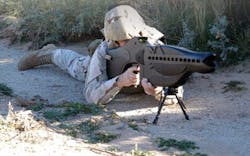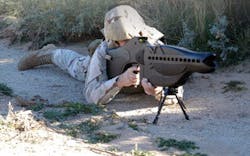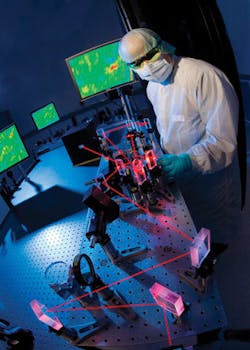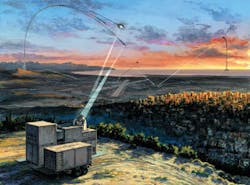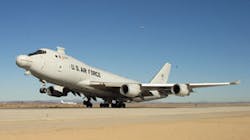The military’s laser weapons programs are making steady progress in their transition from the laboratory to the battlefield, with deployment of initial systems expected within the next three to five years.
By John McHale
Laser weapons, long seen only in laboratories, Hollywood movies, or science fiction, are nearing deployment.
Programs are under way for laser weapons applications for the U.S. Navy, Air Force, Army, and Marine Corps. However the one furthest along and the one that has soaked up the most funding is the Missile defense Agency’s (MDA’s) Airborne Laser.
The Airborne Laser will provide a speed-of-light capability to destroy all classes of ballistic missiles in their boost phase of flight. Prime contractor Boeing provides the modified aircraft and the battle-management system and is the overall systems integrator. Airborne Laser partners are Northrop Grumman, which supplies the high-energy laser and the beacon illuminator laser, and Lockheed Martin, which provides the nose-mounted turret and the beam control/fire control system.
Boeing, industry teammates, and the MDA earlier this year fired the Airborne Laser weapon system’s tracking laser in-flight at an airborne target for the first time.
“The Airborne Laser team has successfully transitioned to the next major test phase, completing the first in a series of in-flight laser firings at an airborne target,” says Pat Shanahan, vice president and general manager of Boeing Missile Defense Systems. “This first firing confirms that the Airborne Laser can find an airborne target, precisely fix the track illuminator laser onto that target, and use the laser firing results to track the target. This is an important step toward demonstrating the aircraft’s ability to engage a flying target.”
During the test, the Boeing 747-400F modified jetliner took off from Edwards Air Force Base, Calif., and used its infrared sensors, part of the Airborne Laser’s Boeing-developed battle management system, to find the simulated missile exhaust generated by an instrumented target board located on the U.S. Air Force’s NC-135E Big Crow test aircraft. The Airborne Laser aircraft then pointed and fired its track illuminator laser (TILL) at the target to gather target-tracking data, a key step in a missile engagement. The TILL, a solid-state laser, is part of the Airborne Laser’s beam control/fire control system developed by Lockheed Martin.
In upcoming flight tests, the Airborne Laser will fire its other solid-state laser, the beacon illuminator laser, together with the TILL to demonstrate the ability to compensate for the atmospheric turbulence that the missile-killing, high-energy chemical laser would encounter in its path to the target. The aircraft then will complete an engagement sequence by firing illuminator lasers and using a surrogate high-energy laser to simulate a target shootdown.
When these tests are completed, the program will install the actual Northrop Grumman-built high-energy laser in the aircraft to prepare for the first intercept test against an in-flight ballistic missile in 2009.
Last year Northrop Grumman engineers finished ground-testing the optics that will shape the high-energy laser beam and direct it from the laser to the beam-control/fire-control system. The optics were inspected and refurbished after the laser achieved lethal power and run-times in a ground laboratory in December 2005.
Other program highlights last year included integrating the Lockheed Martin-designed beam-control/fire-control system inside the Airborne Laser aircraft, a modified Boeing 747-400F. Two solid-state illuminator lasers, which are part of the beam-control device, and a surrogate high-energy laser were installed and fired repeatedly at a simulated ballistic missile target. The track illuminator laser is designed to track a target, while the beacon illuminator laser is intended to measure atmospheric turbulence that the high-energy chemical laser would encounter in its path to the target. During the ground tests, results from the illuminator firings were fed back to the Airborne Laser, allowing the surrogate high-energy laser to shoot down a simulated target.
Solid-state lasers
Many of the programs that expect to bring laser weaponry into the hands of the warfighter on the ground involve solid-state laser technology. Fiber lasers are more efficient, more easily cooled, are small and lightweight, and are relatively straightforward to scale up in power, which strengthens their position for future laser weapons programs.
The U.S. Army is funding the Joint High Power Solid-State Laser (JHPSSL) program to develop “military-grade,” solid-state laser technology that is expected to pave the way for the U.S. military to incorporate high-energy laser systems across all services, including ships, manned and unmanned aircraft, and ground vehicles.
The industry and government teams behind the effort have achieved a 25-kilowatt laser and are still working on achieving the 100-kilowatt plateau, says Rich Garcia, spokesman for the Directed Energy Directorate (DED) at the U.S. Air Force Research Laboratory (AFRL) at Kirtland Air Force Base, N.M.
U.S. Air Force researchers launched a research project earlier this year to explore innovative techniques and approaches in advanced fiber laser systems. This announcement comes at the same time as an announcement by Northrop Grumman Corp. to build a specialized facility for systems integration and production of high-energy laser systems for military uses.
Located at the Northrop Grumman Space Technology sector’s Redondo Beach, Calif., campus, the Directed Energy Production Facility is specifically designed for the production of high-energy, solid-state lasers and their integration onto military vehicles. The first work in the facility will be for Phase 3 of the Joint High-Power Solid State Laser (JHPSSL) program, which will build and demonstrate the first 100-kilowatt solid-state laser sufficient for a variety of force protection battlefield and precision strike missions. The facility also will house other laser systems the company is spearheading.
The facility will provide the capability to produce current and future generation technologies of lasers including fiber lasers even more powerful than 100 kilowatts. There will also be an integration area where electric lasers are integrated onto various military platforms, such as armored combat vehicles. With class 1,000 cleanrooms and integrated laser safety systems, the facility can produce multiple laser systems at the same time.
DED officials issued a presolicitation notice Jan. 12 of their interest in receiving proposals for developing an innovative high-power fiber laser, as well as for a diode-pumped alkali laser.
The effort will be to explore innovative techniques and approaches in four technical areas: development of theoretical models necessary for development of advanced pulsed and continuous-wave fiber laser systems; experimental design and construction of a high-power fiber laser array; design of an experimental high-power photonic crystal fiber amplifier and test system; and development of models aimed at the Air Force Research Laboratory’s hybrid diode pumped alkali laser.
Air Force experts say they were to award one 12-month contract in April, which was to be worth about $300,000.
To investigate the effect of a high-energy laser in air-to-air combat, AFRL performed a Tactical High-Energy Laser Utility Study (THELUS) in a virtual simulation environment. As a follow-on to a previous test, AFRL scientists performed simulated tests of air-to-air engagement involving two aircraft versus four. For the test effort, six tactically rated pilots divided into two teams: red and blue. To acquire baseline data, the researchers first provided both teams with identical weapons and sensors; they later modified the blue team configuration to include the directed-energy weapon (DEW), while the red team retained its conventional weaponry.
To determine the DEW’s effects on the mission, the researchers altered two distinct characteristics of the DEW throughout the test scenarios, changing the maximum sensor range (which determines how far pilots can see with the DEW) and the thermal budget (which determines how long pilots can fire continuously). The testing determined both survivability and mission success under the altered conditions. DEW utilization resulted in a greater probability of at least one pilot surviving the mission, AFRL offices say.
PHaSR
In the man-portable category researchers at Kirtland are developing the Personnel Halting and Stimulation Response (PHaSR), a rifle-size laser weapon that uses two nonlethal laser wavelengths to deter, prevent, or mitigate an adversary’s effectiveness. The laser light generated by this weapon illuminates or “dazzles” aggressors, temporarily impairing individuals and their ability to see the laser source. PHaSR can be operated by a single operator and incorporates an innovative power source that makes the system completely self-contained, Kirtland officials say. The system uses two low-power diode-pumped lasers-one visible wavelength and one mid-infrared wavelength.
The system was designed for military and law enforcement applications by ScorpWorks, a research unit in the Laser Division of the DED. Also involved in its development was the Laboratory’s Human Effectiveness Directorate at Brooks City Base, Texas, which characterized the system to ensure it can operate safely and continues to study the biological effects.
In some respects the weapon was designed by Hollywood, Garcia says. Kirtland researchers borrowed a prop design from a movie company for the modular weapon case, he adds.
Funding for PHaSR came from the Joint NonLethal Weapons Directorate and the National Institute of Justice: the former organization interested in the technology for military applications and the latter for civil law enforcement uses.
The PHaSR is still in development, Garcia says. Engineers are “incorporating a range finder that optimizes energy at the right distance,” he adds.
In the past, illuminator lasers such as PHaSR have been too powerful at close ranges and ineffective at long ranges when eye-safe. The PHaSR version now under development by the ScorpWorks will incorporate an eye-safe laser range finder so that the maximum safe laser energy can be placed on target, regardless of range-near or far, Kirtland officials say.
One of the Directorate’s earlier illuminator lasers works was Saber 203, which used a semiconductor laser to give it an effective range of 300 meters. The laser was specially fitted into an M16 combat rifle carrying a 40-millimeter grenade launcher.
Saber 203 had two parts. One was a metal capsule about the size and shape of a 40-millimeter grenade that housed the laser emitter. An operator would load the capsule into the launcher as if it were an actual grenade. The second component was a battery pack that snapped on to the weapon’s underside. A button on the battery pack “fired” the laser in a continuous or pulsed beam to illuminate a target. In an emergency, the capsule could be ejected quickly and replaced with a grenade.
Lightweight, simple to operate, and easy to handle, Saber 203 could also be used as a laser designator and could counter night-vision devices. The system was used in 1995 by U.S. Marines in Somalia during Operation United Shield.
Saber 203 led to the development of the Battlefield Optical Surveillance System, or BOSS. This was a grouping of lasers, optics, sensors and communications equipment mounted on a Humvee.
Among its components was a doubled Nd:YAG (green) laser or an optional red laser that could be used to visibly designate a threatening individual. The threatening individual’s reaction to visible illumination would help determine his intent: if hostile, direct force could be used; if nonhostile, firing lethal rounds could be averted, Kirtland officials say.
Laser Gunship Program
Boeing in St. Louis has begun flight testing for the Advanced Tactical Laser (ATL) Advanced Concept Technology Demonstration (ACTD) program and has generated “first light” of ATL’s high-energy chemical laser in ground tests, achieving two key milestones in the laser gunship development effort.
During the “low-power” flight tests, a low-power, solid-state laser will serve as a surrogate for ATL’s high-power chemical laser. To prepare for the tests, the ATL aircraft, a C-130H turboprop aircraft from the U.S. Air Force 46th Test Wing, was outfitted with flight demonstration hardware at Crestview Aerospace Corp. in Crestview, Fla. The hardware includes the beam director and optical-control bench, which will direct the laser beam to its target; and weapon-system consoles, which will display high-resolution.
Boeing fired the high-energy chemical laser for the first time in ground tests early in Fall 2006-an achievement known as “first light.” By 2007, Boeing will install the device on the aircraft and fire it in-flight at mission-representative ground targets to demonstrate the military utility of high energy-lasers. The test team will fire the laser through a rotating turret that extends through an existing 50-inch-diameter hole in the aircraft’s belly.
Boeing is developing ATL for the U.S. Department of Defense through an ACTD program.
ATL will destroy, damage, or disable targets with little to no collateral damage, supporting missions on the battlefield and in urban operations. ATL will produce scaleable effects, meaning the weapon operator will be able to select the degree and nature of the damage done to a target by choosing a specific aimpoint and laser shot duration. For example, targeting the fuel tank of a vehicle could result in total destruction of the vehicle, while targeting a tire might result in the vehicle stopping without injury to the driver.
Boeing’s Advanced Tactical Laser industry team includes L-3 Communications/Brashear, which made the laser turret, and HYTEC Inc., which made various structural elements of the weapon system.
Skyguard
Northrop Grumman Space Technology engineers in Redondo Beach, Calif., developed the Skyguard laser-based air-defense system for U.S. government agencies and allies that require near-term defense against short-range ballistic missiles, short- and long-range rockets, artillery shells, mortars, unmanned aerial vehicles, and cruise missiles.
Skyguard is derived from the successful Tactical High Energy Laser (THEL) test bed and its predecessors developed by Northrop Grumman for the U.S. Army and the Israel Ministry of Defense. Benefiting from significant technological advancements, Skyguard has higher power than heritage systems and a larger beam, making it a much more capable system, company officials say.
“We believe that no other weapon of any kind, or any system being developed today, can offer the kind of protection we’ve proven Skyguard can provide,” says Alexis Livanos, president of Northrop Grumman Space Technology. “Skyguard offers the earliest possible implementation of an operational laser weapon system for defense against a wide range of threats.”
Like earlier systems developed by Northrop Grumman, Skyguard is a multimission, soldier-operated, compact, and transportable weapon system designed for field deployment and operations.
One Skyguard system can defend deployed forces, a large military installation, and/or a large civilian population or industrial area. One Skyguard system is capable of generating a protective shield of about 10 kilometers in diameter, Northrop Grumman officials say.
Skyguard will be approximately one-quarter the size of THEL and be more powerful and more efficient, a Northrop Grumman spokesperson says. The greater efficiency will come from a more efficient fuel magazine that enables more shots to be fired per magazine, he adds. Skyguard will not be mobile by the Army’s definition. It can be moved by truck but is semistationary and off the truck during operation, the spokesman says. It is moved in three standard 20-by-8-foot containers, he adds.
Under the Department of Defense’s Technology Readiness Level, Skyguard is at level 6, with level 9 representing technology that is ready to be fielded, the spokesman says.
“The THEL test bed has demonstrated unequivocally that lasers can engage and destroy rocket, artillery, and mortar threats in flight,” says Mike McVey, vice president of Northrop Grumman’s Directed Energy Systems business area. “This test bed has been remarkable successful. To date, it has shot down dozens of live threats, including long- and short-range rockets, mortars, and artillery projectiles, in very realistic attack scenarios, and under simulated operational conditions such as surprise attacks and mixed threats.”
In continuous use at the Army’s White Sands Missile Range since it was developed between 1996 and 2000, the THEL Testbed has proven that laser weapons could be applied on the battlefield to protect troops on the ground. Like the THEL test bed, Skyguard is a modular and flexible system that will support future spiral developments and can accommodate improved laser- and beam-control technologies as they become available.
Air Force seeks to improve battlefield logistics with recycled laser fuel
Scientists from the U.S. Air Force and the Boeing Co. test fired a laser for the first time using recycled fuel last August at Kirtland Air Force Base, N.M.
“This fuel recycling process can be continued indefinitely, providing a practical way to fuel laser weapons for the Air Force and other military services without the complexity and cost of periodically supplying new fuel to the battlefield,” says Jason A Marshall, a research chemist and the Air Force project officer on the program.
The test at the Air Force Research Laboratory (AFRL) Directed Energy Directorate at Kirtland supplied a chemical laser with its two main fuels-basic hydrogen peroxide and chlorine-which experts regenerated from waste products produced during prior laser operations. Testers fired the laser at high power on the order of several kilowatts to prove its performance.
This achievement “will substantially improve warfighting logistics. This removes the need to dispose of used fuel,” Marshall says. “With the test’s successful conclusion, the laser is ready for affordable, low-risk weapons applications that meet the warfighter’s needs.”
The chemical laser in the demonstration is a test bed similar to the laser device designed for the Advanced Tactical Laser, a major U.S. Department of Defense technology project, Air Force officials say. It involves an Air Force C-130 cargo aircraft that carries the laser, which is intended to destroy, damage, or disable ground targets with surgical precision and cause little, if any, collateral damage.
The test was at the directorate’s Davis Advanced Laser facility where the regenerated fuels were produced in miniaturized electrochemical reactions designed to collect the waste products of laser operations and convert them to fresh fuel.
Boeing Directed Energy Systems in Canoga Park, Calif., is the prime contractor for the Advanced Tactical Laser.
Boeing TSAT laser communications system demonstrates mission-level capabilities and performance
Boeing in St. Louis and its partners became the first team to successfully demonstrate the ability of its Transformational Satellite (TSAT) laser communications system to deliver high-power operations at three data rates during recent U.S. Air Force tests.
The tests, which built on the capabilities and performance verified during three previous demonstrations, validated the system’s performance to, and interoperability with, government laser communications standards.
The tests, conducted at the Massachusetts Institute of Technology’s Lincoln Laboratory in Lexington, Mass., verified the traceability of results achieved during a February 2006 demonstration and evaluated the capabilities and performance of the upgraded telescope, new optical high-powered amplifier, and additional data rate. The Boeing team completed communications performance and pointing, acquisition and tracking tests for 2.5, 10, and 40 gigabits per second data rates.
TSAT will provide a secure, long-haul, high-capacity communications backbone for U.S. forces to ensure they have information superiority in any situation throughout the world. Boeing currently is executing a TSAT Space Segment Risk Reduction System Definition contract for the Space and Missile Systems Center, U.S. Air Force Space Command.
The brassboard-level hardware suite demonstrated consists of a precision space telescope and pointing electronics developed by Ball Aerospace & Technologies Corp.; an optical high-powered amplifier developed by LGS Innovations (formerly Lucent Technologies); and a low noise amplifier and optical modems developed by Boeing.
Additional Boeing-funded demonstrations and environmental testing of the components in early 2007 will support the government’s requirement for laser communications maturity prior to the Space Segment Design Review in April 2007.
Nufern releases new fibers for couplers and FBGs
Nufern, an independent manufacturer of fiber laser and amplifier modules and specialty optical fibers in East Granby, Conn., announced the expansion of its NuCOMM line of specialty telecom fibers with the CMS-HP and the 980C-HP.
CMS-HP is a photosensitive single-mode fiber designed for the production of complex Bragg grating structures, such as those with high channel count, in which cladding mode suppression is a fundamental requirement.
“This fiber sets a new standard for photosensitive telecom fibers,” says Dr. Adrian Carter, chief technology officer at Nufern, “with its excellent cladding mode suppression, high intrinsic photosensitivity, and low birefringence.”
Optimized for low polarization mode dispersion (PMD), the fiber enables production of devices such as dispersion compensating modules, with low polarization-dependent loss (PDL).
A new coupler fiber, 980C-HP, is designed to achieve extremely low bend loss and splice loss, making it ideal for couplers of all sorts, and other ultracompact components requiring small bend radii. In addition to its bending and splicing performance, the fiber’s tight second mode cutoff tolerance and high tensile strength allow coupler manufacturers to achieve improved production yields and reduced manufacturing costs.
For more information, visit www.nufern.com.
